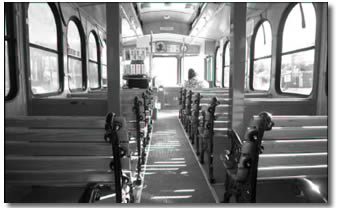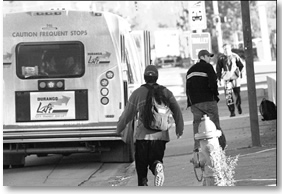If there’s one thing nearly everyone agrees on, it’s
that the car is currently king in Durango. For many local residents,
the Durango Lift has nothing to do with the ideals of preventing
congestion and pollution, but is a system dedicated to serving
 |
| A
lone passenger rides the Main Avenue Trolley on Monday.
The Durango Lift, which operates the trolley, has been providing
local transportation service since 1983, but the system
is now facing a two-fold dilemma – increased growth
in the face of decreased funding. |
people who can’t afford automobiles. However, given the
current steady growth in traffic and unprecedented development
on the horizon, new energy is going into transportation alternatives
and, specifically, public transit.
Ted Holteen kicked down 50 cents and rode the Durango Lift’s
trolley from his home on 29th Street to his job in the Town
Plaza on Tuesday. He says he regularly rides the bus and has
for years. When asked specifically why he rode Tuesday, he responds,
“My car is broken down at the moment, and when I can’t
borrow my roommate’s, I ride the trolley.”
Vince Haffey also has been riding the trolley and the Durango
Lift regularly, and, like Holteen, he does it out of necessity.
For the last six years, he’s ridden the system every day
to everywhere from the bowling alley at the Durango Mall to
relatives’ homes. He says he likes the frequency and friendliness
of the system but quickly admits that he rides only because
he can’t afford a car.
Holteen notes that in his mind the trolley caters to an unusual
Durango subculture. “It’s always a nice little freakshow,”
he says. “It’s entertaining as well as economic
and efficient.”
A car town
Jan Choti is the transit manager for the Durango Lift, the
umbrella organization for the Main Avenue trolley, which charges
50 cents; the Opportunity Bus, which serves people with disabilities;
and the Durango Lift, which runs several loops around Durango
and charges $1 per ride.
Choti is the first to admit that Durango is literally driven
by automobiles. “Durango is absolutely a car town,”
she says. “It would take something drastic to change that.”
However, Choti stands by cutting down on congestion and pollution
and has hope  for
Durangoans in spite of their love for vehicles. “I would
like to see everyone make a commitment to, one day a week, leaving
their car at home,” she says. “I’m not asking
them to change their lifestyle or sell their cars.”
for
Durangoans in spite of their love for vehicles. “I would
like to see everyone make a commitment to, one day a week, leaving
their car at home,” she says. “I’m not asking
them to change their lifestyle or sell their cars.”
Choti notes that last year, the Durango Lift provided more than
200,000 rides, and many of those were given to repeat riders
like Haffey and Holteen. While the number of trips last year
seems impressive, she adds that public transit has not always
been on the top of people’s lists in Durango, particularly
when it comes to funding it. “Here, it’s been an
uphill fight to get people to realize that transit is very expensive,
and it needs to be subsidized,” Choti says.
She adds that the Durango Lift is under-appreciated and that
few communities Durango’s size have such sophisticated
bus systems. “I wish that the people would recognize how
advanced the system is,” she says. “We provide a
level of service that doesn’t exist in other communities
of 15,000 people.”
An uncomfortable twist
The Durango Lift has been operating since 1983, but the system
is now facing a significant dilemma – increased growth
pressure in the wake of decreased funding. Greg Hoch, Durango
planning director, notes that the combined forces of the proposed
Grandview, Ewing Mesa and Kroeger Ranch developments could make
for 4,800 new Durango homes and twice that many new cars. As
planners eye this proposition, their single, biggest concern
is transportation.
“I think transportation and street capacities are going
to be the most challenging element in this city and county’s
ability to respond to growth challenges,” says Hoch.
Part of the reason transportation will be such a challenge is
the State of Colorado’s recent failure to allocate resources
locally, according to Hoch. Consequently, city, county and state
officials are trying to get creative on the behalf of Durango.
“I think what’s going on locally is that there’s
a recognition on the part of elected city, county and state
officials and staff that everybody has to come together and
agree on a solution and lobby for that solution at the state
level,” he says.
On the local level, Hoch says the city has recently begun to
look at new approaches to transportation and public transit.
“Since 1983, the bus system has reacted to development,”
he says. “Now we’re trying to make it more proactive,
where we design the new development to accommodate transit services.
We are moving in a direction to incorporate transit planning
in all of our project-review planning.”
Features like bus stop locations and shelters will be addressed
as well as a possible regional transfer station.
“It’s a very recent development that transit will
be included in some of the early phases of planning these developments,
and it’s time” says Choti. “These are simple
little amenities that we don’t have yet.”
Choti says one of the most important places to consider in terms
of future transportation is downtown Durango. “I think
we need to look at the downtown area and decide if we’re
really getting around there in the best possible way,”
she says.
To that end, the city and the Durango Lift are looking into
the feasibility of a park-and-ride system, where people would
park in areas like the Eight Corners intersection in Bayfield,
Elmore’s Corner and Durango West and ride a bus into town.
Choti adds that she would like to see the frequency of the trolley
increased from every 20 minutes to every 10 minutes. She also
would like to work toward a goal of regional transit for commuters
from Dolores, Cortez and Ignacio. She says that while these
are all long-term fixes, some should come about sooner than
others, and the planning must begin immediately.
“You have to start planning for it now because lands going,
and going quickly,” she says.
However, the biggest difficulty is funding, particularly after
a summer in which sales tax revenues, the city’s principle
funding mechanism, plummeted. “These are all things that
cost money,” says Choti. “”We’re all
doing the best we can to use the money we have wisely.”
Two other perspectives
 |
| A Durango
Lift passenger runs to make his bus Monday morning on Main
Avenue. The Durango Lift provided more than 200,000 trips
last year, and city officials are looking at ways to increase
ridership. |
Funding dilemmas are not unique to La Plata County’s
public transportation. In Grand Junction, Grand Valley Transit
deals with a similar funding structure and a similar desire
to expand. “It would be nice to have more funding to accommodate
more people in the town,” says Roger Ford, the system’s
chief operating officer.
Grand Valley transit, which charges 50 cents a ride, did more
than 570,000 trips last year, representing a “pretty good
cross-section” of the Grand Junction community. However,
Ford says that the driving force behind this number was a negative
one. “The traffic situation is becoming fairly horrendous
here,” he says. “Naturally, at a point, the number
of cars and the amount of pollution become deterrents to driving
your car.”
East of Grand Junction, a much smaller community hosted a similar
volume of bus traffic last year. Crested Butte’s Mountain
Express did more than 500,000 trips last year, in spite of serving
only 2,500 year-round residents. Although many of the riders
were tourists, the local community is committed to riding the
bus. Mountain Express Manager Scott Truex cites simplicity as
the leading reason for success.
“I think the secret to our success in the simplicity of
our routes and the short distances we go,” he says. “We’re
carrying large numbers of people about three miles.”
Truex adds that the Mountain Express also has a flexible source
of funding. Sales tax revenues are only one component of funding
the system, which also draws money from a lift-ticket tax. On
election days, voters also approved a Regional Transit Authority,
which will derive additional tax revenues. Although the primary
purpose of the RTA is guaranteeing airline seats, leftover money
will be allocated to ground transportation.
Wait and see
While La Plata County has yet to explore funding mechanisms
outside sales tax revenues, Choti is hopeful that the economy
will bounce back, and the Durango Lift will be able to address
growing needs.
“There’s no doubt that public transit can be a solution
to a lot of problems, but we’re in a literal spending
freeze,” concludes Choti. “It’s a dilemma,
and we’re having to take a wait-and-see approach.”

